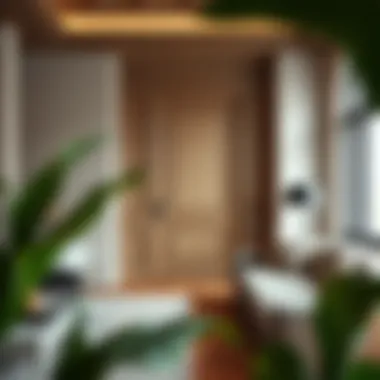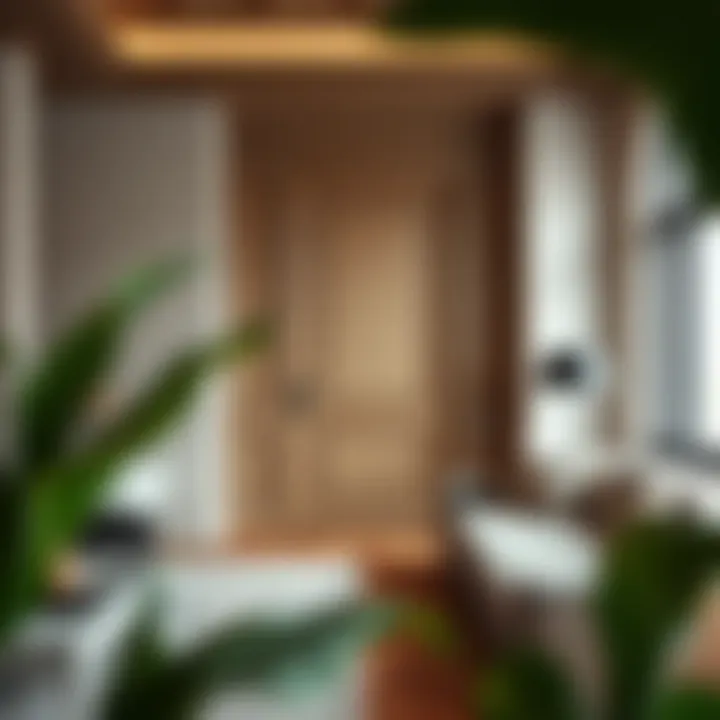Exploring 72 Inch Doors: Design and Practical Insights


Intro
In the world of architecture and interior design, doors often serve as more than just functional entry points. They can dramatically influence the aesthetic appeal of a space and provide insights into the style and personality of a home or building. Among various door options available today, 72-inch doors stand out as a choice that offers both practical advantages and design versatility. This article immerses readers into the realm of these formidable doors, exploring their multifaceted nature, from design trends to essential considerations for those looking to incorporate them into their projects.
Furniture Design Trends
Current Styles and Aesthetics
When it comes to 72-inch doors, one notable trend is the preference for wider openings. This design choice reflects a movement toward open-concept living, where heavy walls are replaced by airy spaces more conducive to social interaction. Modern design often favors clean lines and minimal hardware, allowing the doors themselves to be the centerpiece.
In many settings, especially in contemporary homes, sliding glass doors are becoming increasingly popular. These doors bring the outside in and invite natural light, creating a seamless transition between indoor and outdoor environments.
"A well-chosen door can enhance the flow of indoor spaces and frame beautiful views, transforming the way we experience our surroundings."
Color Palettes and Materials
The choice of materials and colors plays a pivotal role in the overall appeal of 72-inch doors. Recent trends show a growing inclination towards sustainable materials, such as bamboo or reclaimed wood, that speak to both environmentally conscious homeowners and designers.
Popular color choices vary significantly based on the intended style. For a bold look, deep earth tones or even striking blacks might be favored, bringing a dramatic touch to the entryway. Alternatively, soft whites or light grays often convey a more tranquil atmosphere, offering a stark contrast to vibrant interior hues.
Materials also vary, with options ranging from fiberglass, which provides durability and energy efficiency, to solid wood, celebrated for its classic appeal. Metal doors, especially those designed for industrial-style spaces, cater to avant-garde tastes and can add a unique textural element.
Buying Guides
Essential Considerations When Purchasing
Before diving into the purchasing phase, there are several key factors to weigh.
- Space Requirements: Measure the frame and surrounding area to ensure the door can be installed without obstruction.
- Style Compatibility: Consider how the door complements existing architectural elements.
- Material Suitability: Different materials perform differently in terms of durability and maintenance. Think about the local climate and how it might affect your door choice.
- Security Features: For exterior doors, security shouldn’t take a back seat. Ensure your selection includes robust locking mechanisms.
Top Recommendations for Different Budgets
For homeowners seeking advice on options that won't break the bank, consider:
- Budget-Friendly
Look for brands like Masonite or Jeld-Wen, which offer quality doors at affordable prices. - Mid-Range
Pella and Andersen provide excellent durability and style without exorbitant costs. - Luxury Options
If money is no object, custom manufacturers like eLumen give you the freedom to create a statement piece tailored to your precise needs.
By exploring the benefits of 72-inch doors and considering current trends, design choices, and practical tips for purchasing, readers are better equipped to make informed decisions. Understanding these elements not only enhances the design of residential or commercial spaces but also brings functionality and style together in a harmonious way.
Preface to Inch Doors
The relevance of 72 inch doors in architectural design cannot be overstated. In both residential and commercial spaces, these larger doors serve as a statement piece, contributing to an open and inviting atmosphere. The design choices we make in our living and working environments can significantly impact how we experience those spaces.
Firstly, understanding door measurements is more than just a matter of numbers. The height of a door influences the overall perception of a room and can affect elements like lighting, ventilation, and even traffic flow. The standard height for a door is typically 80 inches; however, 72 inch doors provide a diverse option that can cater to specific aesthetic goals or functional requirements. Designers and homeowners alike appreciate the ability to customize their surroundings, and 72 inch doors can create a distinctive impact that shorter doors cannot match.
Understanding Door Measurements
When it comes down to it, door measurements serve not only a functional role but also a psychological one. A 72 inch door is an uncommon choice, challenging the conventional design approaches that often favor the standard dimensions. By opting for such size doors, one can play up the verticality of a space, drawing the eyes upward and making areas feel less cramped.
- Height and Width: The height generally helps in managing how spacious a room feels. While width varies, a 72 inch door might generally pair with widths of 36 or 42 inches, allowing for smoother lines and a more impressive transition between rooms or to the outdoors.
- Proportionality to Space: Consider the proportion of doors to walls and furniture. A merely functional door can often blend into the background. But a larger-than-average door can be an artistic choice, creating a balance between functionality and aesthetics.
Importance of Door Size in Design
The size of a door plays a pivotal role in both form and function. Larger doors, like the 72 inch version, can add a level of sophistication to a space that smaller doors might lack. It’s about establishing a sense of grandeur while also focusing on usability. This is particularly apparent in homes with high ceilings or expansive areas.
Accessibility is another vital consideration. A 72 inch door makes it easier to bring large items in and out of spaces, which is beneficial for transportation of furniture or equipment. Thus, practicality marries style beautifully.
Not only that, but a door of this size allows for more natural light to flood into a space when it is left ajar. Light has a transformative effect on how we perceive a room; the right amount of illumination can make a big difference in ambiance. The larger your door, the more light can penetrate, enhancing the overall visual experience.
Additionally, considering the cultural significance is important as well. In various traditions, larger doors symbolize welcome and accessibility, thus instilling a sense of hospitality.
"A door isn’t just an entrance; it acts like a frame for how we engage with our surroundings."
Thus, when contemplating the significance of 72 inch doors, one must also appreciate how their size contributes to various dimensions of design, ranging from aesthetics to functionality.
Design Aesthetics of Inch Doors
The appearance of a door can significantly affect the overall aesthetics of a space. For 72 inch doors, their design is not just about looks; it embodies a connection between functionality and style. When selecting a door, understanding its design characteristics can offer insight into how well it can blend with your home's architecture, creating an inviting environment. This section explores the various design aesthetics, emphasizing styles and trends, as well as the customization options available to enhance the usage of 72 inch doors.
Styles and Trends
Contemporary
The contemporary style in 72 inch doors is marked by clean lines and minimalist designs. One of its key characteristics is simplicity, often accompanied by large glass panels that maximize natural light, making spaces feel more open. Many homeowners opt for a contemporary design when they want to create a modern atmosphere that feels both sleek and spacious. The unique feature of contemporary doors is the innovative use of materials such as aluminum or high-grade composite, which often leads to better energy efficiency.
However, the sleek nature of contemporary doors might not fit every design scheme. In homes with more traditional styles, this stark modernity could seem out of place. So, while contemporary is a popular choice, it requires careful consideration of the overall decor.
Classic


The classic design of 72 inch doors pays homage to traditional styles that never go out of fashion. These doors often feature intricate detailing, such as raised panels and rich wood finishes. A key characteristic is their versatility; classic doors can complement various styles, from Victorian homes to more colonial structures. Their charm lies not just in their aesthetic appeal but also in their durability; quality materials ensure longevity in both function and form.
Unique features of classic designs often include ornate carvings and rounded edges, creating a welcoming feel that many find appealing. On the downside, they might require more maintenance, especially if they are wooden. Regular staining or painting is essential to preserve their grandeur, which could deter some homeowners looking for more low-maintenance options.
Rustic
Rustic 72 inch doors convey warmth and a sense of homeliness, often showcasing natural materials like reclaimed wood. The key characteristic of rustic designs is their handmade quality, emphasizing rough textures and organic shapes that reflect a connection to nature. This style is particularly beneficial for those looking to create a cozy atmosphere in their interiors, particularly in countryside or cabin-like settings.
A unique feature of rustic doors is the visible imperfections and variations in wood that add character. While many appreciate this authenticity, not everyone may find it suitable for a more polished or urban aesthetic. Rustic designs may also pose challenges in insulation, making it critical to choose quality options that blend style with functionality.
Customization Options
Materials
When it comes to materials, homeowners have a plethora of choices, making it an integral aspect of customizing 72 inch doors. Wood remains a traditional favorite due to its timeless quality and natural aesthetics. However, modern materials like fiberglass or steel are gaining popularity for their durability and resistance to weather.
Key benefits of different materials:
- Wood: Beautiful and easy to refine but may warp over time.
- Fiberglass: Excellent for energy efficiency and mimics the look of wood but can be pricier.
- Steel: Offers security and strength, yet can be prone to dents.
Choosing the right material requires balancing aesthetics with practical needs, ensuring the door fits its intended environment while serving its functional purpose.
Finishes
Finishing options can dramatically alter the entire look of a door. Available choices range from stains that enhance the natural grain of wood to bold paints that can transform an otherwise simple door into a focal point.
Key characteristics of finishes include:
- Stain: Preserves the natural look of wood and is easier to apply than paint.
- Paint: Offers a broader color palette for those looking to make a statement but might hide the natural beauty of the material.
Depending on aesthetic preferences, a well-chosen finish can enhance or completely change the door’s appearance, making it important to consider the overall design language of the home.
Hardware
The hardware selected for a 72 inch door plays a significant role not just in functionality but also in aesthetics. From sleek handles to ornate hinges, hardware can complement or clash with the door's design.
Key characteristics of hardware options:
- Sleek finishes like matte black or brushed nickel tend to suit contemporary tastes well.
- Ornate brass or detailed wrought iron fits beautifully into classic or rustic designs.
Appropriate hardware choice can elevate the overall design, tying everything together effectively, though it may also add to costs, especially for custom or high-quality pieces.
"A well-designed door is more than just an entrance; it’s a statement piece that speaks volumes about your taste and style."
Functional Benefits of Inch Doors
When it comes to doors, size matters, and 72-inch doors offer unique advantages that can’t be ignored. They serve as more than just entry points; they embody functionality, style, and ease of use. In this section, we’ll dive into the specific functional benefits these grand doors provide, making them an increasingly popular choice in both residential and commercial settings.
Enhanced Accessibility
The height of 72 inches plays a pivotal role in enhancing accessibility. Whether it’s for the elderly, those with disabilities, or simply moving large items, wider and taller doors can significantly ease movement. Think about it—furniture deliveries, moving vehicles, or even just carrying heavy boxes can become a less strenuous task when you have the right door for the job.
- Clear Passage: A large doorway helps minimize the squeeze factor when maneuvering through with bulkier items.
- Wheelchair and Stroller Friendly: When accommodating wheelchairs or strollers, the additional height and width ensure that users can glide through without a hitch.
Moreover, the design of these doors often considers the principles of universal design, ensuring that they fulfill accessibility standards laid forth in regulations such as the Americans with Disabilities Act (ADA). This not only enhances usability but also promotes inclusivity, making homes and buildings welcoming to everyone.
"Access for all isn't just a goal; it's a necessity in modern design."
Improved Natural Light
Another significant benefit of 72-inch doors is their capacity to boost natural light in your surroundings. A taller door often means larger glass panels, allowing sunlight to flood in. This not only brightens a room but also creates a lively atmosphere.
- Energy Efficiency: Using natural light reduces the need for artificial lighting, which can overall lower energy costs. Good design can harness daylight to not only illuminate spaces but also conserve energy.
- Emotional Well-being: Numerous studies indicate that natural light positively influences mood and productivity. Who wouldn't want a home that feels warm and inviting?
Incorporating large doors can open up spaces significantly, creating a seamless flow between the indoors and outdoors. This transition invites nature in, providing breathtaking views and a connection to the surrounding environment. As such, they are often featured in modern architecture, offering an aesthetic appeal that complements functionality.
In summary, opting for a 72-inch door is not just about making a statement; it’s about designing spaces that prioritize ease of access and the benefits of natural light.
Learn more about accessibility standards here.
Discover the impacts of natural light in architecture.
Considerations for Installation
When you're planning to install a 72-inch door, there are several crucial factors that must be taken into account before you dive in. These doors, being larger than standard ones, come with their own set of challenges and requirements. Understanding these can help steer clear of potential pitfalls and ensure a seamless installation.
Structural Requirements
First and foremost, let's talk about the structural requirements. A 72-inch door is significantly heavier and bulkier than its standard 36-inch counterparts. It’s imperative that the frame and surrounding wall structure can support this added weight.


- Framing: Consider reinforcing the door frame. This might involve using thicker studs or adding blocking to prevent the frame from bowing or shifting over time.
- Load-Bearing Walls: If the door is being installed in a load-bearing wall, consulting a structural engineer or a qualified contractor may be necessary. They can provide insight into how the installation will affect the wall's integrity.
- Headroom: One also needs to account for head clearance. A taller door could interfere with overhead beams or ceilings, which might require adjustments in ceiling height.
Understanding these structural nuances ensures not only the safety of the door but also the aesthetics of the home.
Appropriate Hardware Choices
Next up is making the appropriate hardware choices. Choosing the right hardware for a 72-inch door goes beyond mere appearance; it holds the door's functionality and security in its grip. A larger door needs robust, durable hardware to support its weight and frequent use. Here are some things to ponder:
- Hinges: Standard hinges may not cut it; opt for heavy-duty varieties, like T-hinges or continuous hinges, that can share the weight load more efficiently.
- Locks: Consider investing in high-security lock systems. The larger surface area of a 72-inch door could present more challenges against unauthorized entry, making quality locks essential.
- Handles and Knobs: Ensure that the door handle or knob is ergonomically designed for ease of use, particularly if this door will be accessed frequently.
By investing time and resources into the right hardware choices, you can enhance both the longevity and security of your door.
Professional Installation vs. DIY
Lastly, let’s weigh the pros and cons of professional installation versus DIY. While some homeowners relish the challenge of a DIY project, larger doors can introduce complexities that may not be worth tackling solo.
- Skills and Tools: Installing a 72-inch door might require specialized tools and skills. If you lack experience with heavy fittings, hiring a professional versed in door installation can save time and avoid costly mistakes.
- Time Commitments: DIY projects can take longer than anticipated. Professionals generally work more efficiently due to experience, so you'll likely enjoy a quicker turnaround when you hire out.
- Warranties: Some companies offer warranties on installation. If you do it yourself, this level of protection might not follow your installation, leaving you responsible should any issues arise.
Overall, weighing the cost of hiring a pro against the potential costs related to errors in a DIY project will help you make a more informed decision.
"Installing a 72-inch door can feel like maneuvering an elephant into a tiny garage. Careful planning and consideration are your best allies to open that door with ease."
Materials Used in Inch Doors
The material chosen for a 72 inch door is not just about aesthetics; it carries profound implications for durability, performance, and overall value. When considering a door of this size, the right material can enhance not only the door's function but also the atmosphere of the space surrounding it. Homeowners, designers, and DIY enthusiasts will benefit from understanding the unique properties of different materials and how they interact with environmental factors, security needs, and aesthetic desires.
Wood
Wood doors are a classic choice that continues to resonate in both modern and traditional designs. Their natural warmth and versatility make them appealing in various contexts. Wood can be carved, stained, or painted, allowing for customization that fits any aesthetic vibe. Furthermore, woods such as oak, mahogany, or cherry offer strong durability and can withstand various weather conditions.
Depending on the type of wood selected, owners might find themselves in need of routine maintenance. A solid wood door tends to require regular sealing and refinishing to maintain its appearance and extend its lifespan. All considerations aside, the unmistakable beauty of a well-crafted wooden door can provide a sense of character and charm.
“The choice of wood can transform a space; it speaks volumes about personal style.”
Benefits of Wood
- Aesthetic Appeal: Available in numerous styles, can complement any decor.
- Insulation: Offers good thermal properties, helps in energy efficiency.
- Soundproofing: Thick, solid wood doors can dampen noise between rooms.
Steel
Steel doors stand out by providing unmatched strength and security. Known for their robustness, these doors are ideal for those who prioritize safety. They can withstand extreme weather conditions, making them suitable for exterior installations. Further, steel doors often come coated with protective finishes that enhance their resistance to rust and corrosion.
While steel has relatively few design options compared to wood, advancements in technology allow for finishes that mimic wood grain or come in various colors. This versatility affords homeowners with different exterior designs the opportunity to choose a robust door without sacrificing style.
Advantages of Steel
- Security: Offers superior resistance against forced entry.
- Durability: Highly resistant to dents and damage.
- Low Maintenance: A quick wipe-down is usually all that's needed to keep it clean.
Fiberglass
Fiberglass doors have come a long way in achieving a balance between practicality and aesthetic appeal. They are lightweight yet strong and impervious to moisture. A fiberglass door won’t warp, crack, or become susceptible to rust, which can make it a smart choice for those in humid climates.
These doors are often designed to imitate the look of wood, providing visual appeal without the upkeep that natural wood demands. When it comes to energy efficiency, fiberglass doors excel, providing high insulation values which can lead to lower heating and cooling costs over time.
Key Attributes of Fiberglass
- Energy Efficiency: Retains temperature, lowers utility bills.
- Variety of Styles: Available in diverse designs that mimic wood or other finishes.
- Resistant to Elements: Can withstand harsher climates that may damage other materials.
In summary, the choice of material for a 72 inch door can significantly impact its performance and aesthetic appeal. Each material provides a unique set of benefits and can be chosen based on the specific needs of the space, whether it be beauty, security, energy efficiency, or durability. By understanding the characteristics of wood, steel, and fiberglass, homeowners can make informed decisions that will enhance their properties for years to come.
Energy Efficiency and Insulation
When we talk about 72 inch doors, energy efficiency and insulation are pivotal themes. These doors play a vital role in maintaining comfortable indoor temperatures while minimizing energy expenditure. In a world where energy costs are climbing, and eco-conscious living is on everyone’s radar, understanding how these doors can contribute to a home’s efficiency is crucial.
Understanding Thermal Performance
To appreciate thermal performance, one must grasp the fundamental principle of insulation: preventing heat transfer. A well-insulated 72 inch door helps keep warmth inside during winter and cool air in during summer. This isn’t just about comfort; it significantly impacts your utility bills.
- Core Materials: The thermal performance largely depends on the materials used. For instance, fiberglass doors often outperform their steel and wooden counterparts in energy efficiency due to their insulating properties. They resist temperature changes better, thereby creating a barrier against heat loss or gain.
- Seal Quality: The seals around a door are not to be overlooked. High-quality weather stripping will keep drafts at bay. Gaps can lead to significant energy loss; hence, ensuring a tight seal is paramount. If you feel a breeze around your door, it’s time to consider a replacement or upgrade.
- Glass Options: If your 72 inch door incorporates glass panels, pay attention to the type of glazing. Double or triple glazing offers more insulation than single-pane glass. Low-emissivity (Low-E) coatings can further enhance performance by reflecting heat back into the home during winter.
"Choosing the right door isn’t just a matter of aesthetics; it significantly influences your energy efficiency. A good 72 inch door can lead to savings you might not even realize until your utility bill arrives."
Choosing Eco-Friendly Options
Making eco-friendly choices in door selection aligns with a sustainable lifestyle. Here's how to choose wisely when it comes to 72 inch doors:
- Sustainable Materials: Opt for doors made from sustainably sourced wood. Certifications like the Forest Stewardship Council (FSC) indicate responsible harvesting practices. This not only supports forests but also adds a unique character to your space.
- Recycled Content: Explore options made from recycled materials. Some manufacturers offer doors composed of composite materials that incorporate recycled wood fibers, appealing to eco-conscious homeowners while still delivering on durability.
- Energy Star Rated Products: When in doubt, look for Energy Star ratings. These products meet strict energy efficiency guidelines set by the U.S. Environmental Protection Agency. An Energy Star certified door can dramatically reduce energy consumption over time, meaning you’ll enjoy the benefits both environmentally and financially.
- Local Sourcing: Choose products manufactured close to home. This reduces the carbon footprint associated with transportation and also supports local businesses.
By weaving energy efficiency and insulation into your choice of a 72 inch door, you not only invest in your property’s aesthetic but also its functional resilience. Always remember: buying smart is as important as buying stylish.


Cost Factors for Inch Doors
When considering 72 inch doors, it's essential to look beyond the aesthetic appeal or functionality—they come with a set of financial implications that can significantly affect your project budget. Understanding these cost factors can be the make-or-break moment for homeowners and designers alike. Well-informed decision-making is key to ensuring that you choose doors that not only meet your design aspirations but also fit your financial plan adequately.
Initial Purchase Considerations
The initial expense of purchasing a 72 inch door encompasses various aspects. First and foremost, the type of material greatly influences the price. Let's say you're contemplating a solid wood door, that will naturally command a higher price than, say, a fiberglass option. Here are some considerations:
- Material Quality: High-quality materials like mahogany or oak will inevitably set you back more than softer materials like pine or engineered wood.
- Design Complexity: Intricate designs or custom features—such as glass inserts or custom finishes—will raise costs. A simple flush door will generally be cheaper.
- Brand Reputation: Sometimes, paying a few extra bucks for a reputable brand can mean superior durability and warranty options, which might save you in the long run.
- Size and Dimensions: As with any oversized item, the cost typically increases with size. A 72 inch door, being larger than standard, comes with an elevation in price simply due to its dimension.
Neglecting to factor in these costs could lead to a surprising dip into your wallet during the purchasing phase.
Long-Term Maintenance Costs
Once you’ve installed your 72 inch door, the costs don’t stop there. Maintenance is often an overlooked aspect that can add up over time. Proper upkeep can cause a notable dent in your budget if you aren't prepared. Here are some important points:
- Routine Maintenance: Wood doors, for instance, may require regular sanding, staining, or sealing to maintain their aesthetic and protective qualities. This can lead to recurring expenses.
- Hardware Replacement: The hinges, locks, and handles might warrant replacement due to wear and tear. If you’re opting for high-end hardware, factor that in as well.
- Weatherproofing Needs: If your area experiences drastic weather changes, you may need to invest in preventative measures like insulation kits or weather stripping to maintain energy efficiency.
- Repairs: Accidental damage or general wear could lead to hefty repair costs based on the material. For example, a cracked fiberglass door could be less expensive to fix than a solid wood door, but both come with their unique challenges and cost implications.
Maintaining an eye on these long-term costs is wise, as they often sneak up on you when you least expect it, turning your shiny new door into an ongoing expense.
"Investing in a door is not just about the purchase price; it’s about the lifespan and maintenance thereafter."
In summary, understanding these cost factors surrounding 72 inch doors can help pave the way for smarter, more informed buying choices. Balancing upfront costs with long-term implications allows homeowners and designers alike to strategize better on their projects.
Trends in Inch Door Usage
As design aesthetics continue to evolve, so too does the usage of 72 inch doors in a variety of settings. These doors have carved a niche for themselves in both modern and rustic designs, bridging the gap between functionality and style. Not only do they command attention with their impressive height, but they also cater to a broad array of needs—from creating spacious entryways to maximizing natural light in a room. Focusing on trends in their usage, it's essential to explore specific elements, benefits, and considerations that make them popular choices in today’s architectural palette.
Modern Architecture Preferences
The current wave of modern architecture often leans toward minimalistic designs, where spaces are kept open and airy. Here, 72 inch doors provide an ideal solution. Their larger frame allows for an unhindered flow of light, creating the illusion of greater space in typically constricted areas. Architects and designers frequently opt for these doors to emphasize verticality in interior spaces, leading to a more dramatic visual effect.
Many contemporary homes feature large, expansive layouts that make standard sizes look out of place. The inclusion of spacious inch doors ties the design elements together seamlessly.
Furthermore, the trend toward open-concept living has also played a significant role in the increased preference for these doors. They can easily blend into the decor, while still serving powerful practical functions, such as providing easy access between rooms or to outdoor spaces. The sleek lines and various material options further enhance their appeal, aligning perfectly with modern sensibilities.
Shifts in Design Philosophy
As society becomes increasingly aware of sustainability and the importance of crafting spaces that reflect personal values, design philosophy is shifting. The trend now focuses on the integration of natural materials and elements that promote sustainability. 72 inch doors can exemplify this philosophy by incorporating eco-friendly materials like reclaimed wood or sustainable steel, allowing individuals to uphold their values while making a design statement.
Additionally, there's a growing interest in biophilic design principles, which prioritize the connection between indoor and outdoor environments. A taller door can facilitate this interaction, drawing the outdoors in and blurring the lines between spaces.
"The right door does not just complete a space; it transforms how that space feels and is experienced."
This design philosophy is also reflected in the customization options available for 72 inch doors. Homeowners and designers can choose features that accentuate their unique tastes and lifestyles, allowing for personalization that wasn’t possible with standard-sized doors.
Comparative Analysis with Standard Sized Doors
When it comes to doors, size often matters more than people realize. This comparative analysis of 72-inch doors alongside standard-sized options lays down the fabric of understanding necessary for homeowners and designers considering their unique spaces. The very first consideration in any door purchase is the purpose it serves; whether enhancing the flow between rooms or acting as a statement feature, these larger doors have much more to bring to the table.
Advantages of Larger Doors
Larger doors, particularly the 72-inch variety, stand as a testament to modern design choices, providing several appealing benefits:
- Enhanced Accessibility: Wider doorways allow for better traffic flow. This can be crucial for households with high foot traffic or for those accommodating wheelchairs, strollers, or large furniture. Making your home more accessible raises comfort levels for everyone.
- Increased Natural Light: A taller door generally allows for larger windows or sidelights, channeling more sunlight into your space. The additional light can lift moods, make spaces feel larger, and reduce the need for artificial lighting.
- Visual Appeal: 72-inch doors often become a focal point of the home’s architecture. They can make a grand entryway, adding significant visual impact that standard doors simply cannot achieve. This statement can enhance not only the entrance but also the perceived value of the property.
- Easier Movement of Items: For homeowners who often deal with transporting large furniture pieces or appliances, having a door that accommodates the width and height required can save both time and effort, making the moving-in or out process much smoother.
Limitations and Drawbacks
While the allure of larger doors is tangible, several limitations and potential drawbacks come into play, especially when juxtaposed with their standard counterparts:
- Higher Cost: Premium materials and custom installations can drive prices up. Unlike standard-sized doors, which are typically mass-produced, 72-inch doors often require bespoke elements that can strain budgets.
- Installation Complexity: Properly installing larger doors can necessitate advanced skills and tools, leading some homeowners to feel the pinch when hiring professionals. Beyond just size, structural adjustments might be necessary, complicating the installation process.
- Space Constraints: Larger doors might not always fit comfortably in certain home layouts. This becomes especially pertinent in narrow hallways or cramped areas where swing space is limited. Homeowners must assess their specific environments to ensure that a larger door won't become a hindrance.
"Choosing the right door size doesn't just affect aesthetics; it can change how a space functions entirely."
- Reduced Resale Marketability: Some potential buyers may prefer the familiarity of standard door sizes, leading to a possible negative impact on resale value. This factor may depend highly on regional trends in architecture.
Summary of Key Takeaways
In this article, we have journeyed through the multifaceted world of 72-inch doors, which are not just functional openings but important components in architectural design. Understanding their place in both residential and commercial settings can greatly influence decisions in terms of aesthetics, accessibility, and efficiency. This section encapsulates the key points addressed, ensuring that homeowners, designers, and DIY enthusiasts can make informed choices when it comes to their door selections.
Recap of Benefits
The benefits of choosing 72-inch doors are numerous and varied. Here’s a summary of the most important aspects:
- Enhanced Entry Experience: The wider frame provides a more inviting approach to spaces, significantly improving the entry experience while promoting a feeling of openness.
- Accessibility: These doors comply with most building regulations concerning accessibility, making them ideal for all occupants, including those using wheelchairs or mobility aids.
- Natural Light: Larger doors often come with options for sidelights or transoms, allowing for more natural sunlight to fill the interior spaces. This can reduce the need for artificial lighting during the day.
- Customization: Homeowners can choose from various materials, finishes, and hardware, which means you can tailor the door to fit your personal style and the overall design theme of your home.
- Market Value: Investing in well-designed, quality doors can increase property value, as modern buyers tend to look for features that enhance both comfort and style.
- Energy Efficiency: Many contemporary 72-inch doors offer commendable insulation properties, keeping homes warm in winter and cool in summer, leading to potential energy savings.
These benefits illustrate how a seemingly simple element like a door plays a critical role in enhancing a dwelling's functionality and overall appeal.
Final Thoughts on Choosing the Right Door
When selecting a 72-inch door, thoughtful deliberation is essential. It's not merely about picking something that looks good; the right door also serves the vital functions of safety, durability, and energy efficiency. Several factors come into play:
- Consider the Style: Whether you're attracted to contemporary, rustic, or classic styles, the design should complement the rest of the space.
- Materials Matter: Understand the properties of different materials like wood, fiberglass, or steel, and consider how they perform under various weather conditions.
- Hardware Selection: The choice of hinges, locks, and handles can not only enhance security but also affect the door's usability and longevity.
- Professional vs. DIY: Determine whether you will need a professional installer or if you are up for a DIY challenge—which can also be a rewarding experience if you possess the necessary skills.
"A door isn't just an entry point; it is a gateway to possibilities, shaped by your vision and needs."















